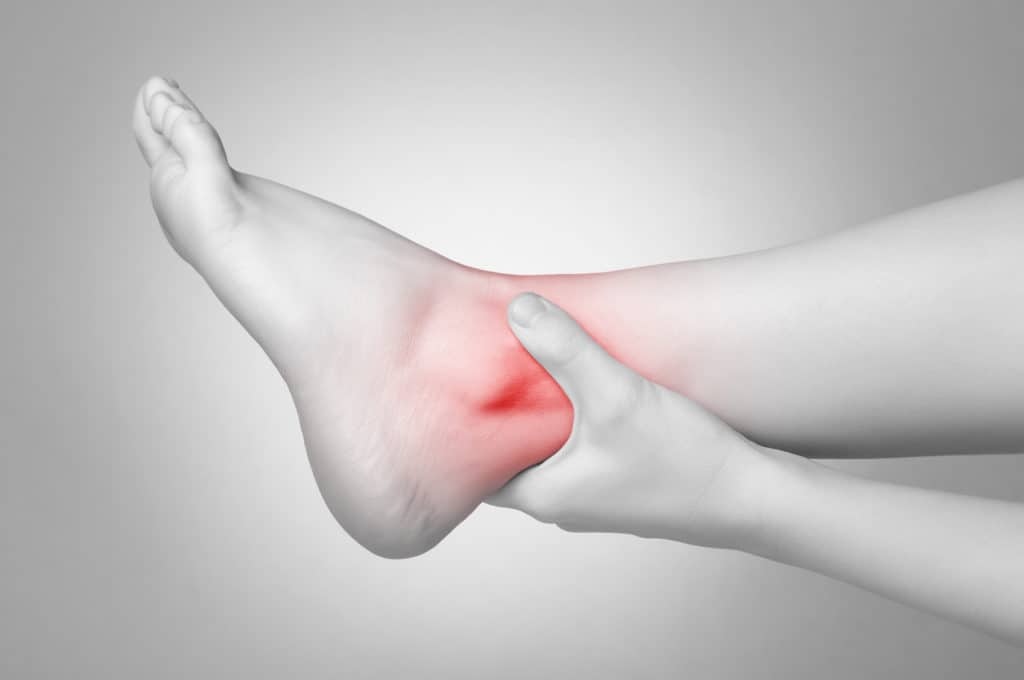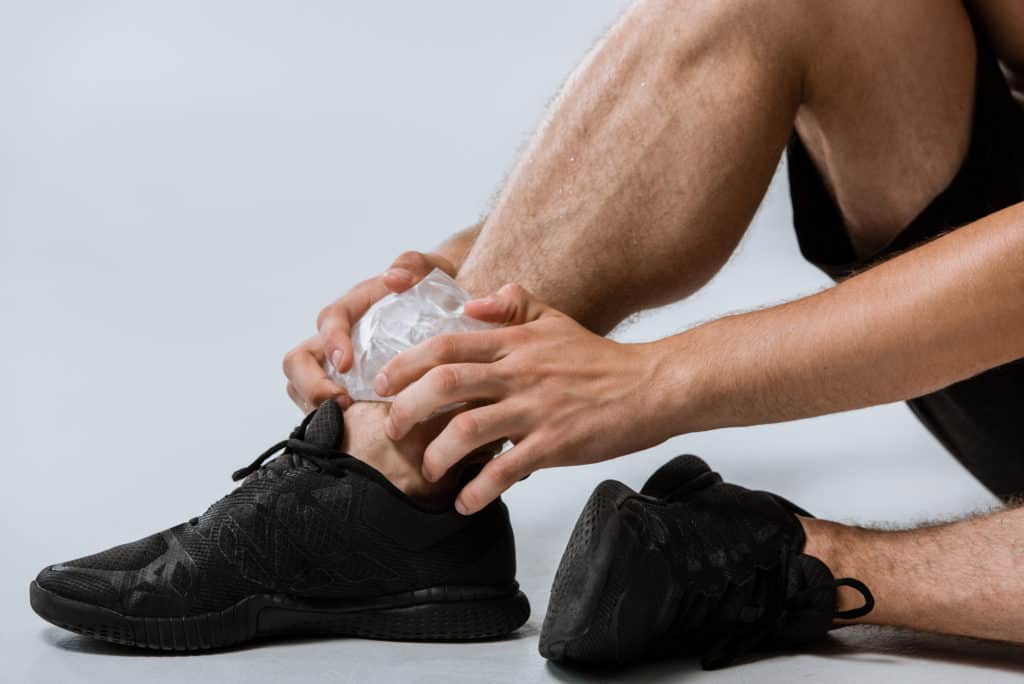
Do you regularly feel stiffness and pain in one or both of your ankle joints? Does it stop you from running, hiking, or playing sports?
It doesn’t have to. If you have any discomfort or pain in or around the ankle joint, we give it a sweeping, catch-all term of “ankle pain.”
But before we can get down to it and fix it once and for all, we need to know precisely what is causing it. Ankle pain isn’t just one thing. It’s many things.
Most ankle pain improves with rest, over-the-counter medications, and ice compresses.
But if you have chronic ankle issues (lasting three months or longer), the pain rarely gets better on its own.
Most people with this type of pain need physical therapy to increase flexibility, strengthen the muscles and prevent further injuries.
Otherwise, the pain can and does get worse. Your pain and swelling may even require treatment with an ankle brace or splint or (in rare cases) surgery to fix an underlying issue.
But physical therapy usually does the trick and can help you avoid surgery altogether.
More Blogs From RPM Physical Therapy:
Tennis Elbow v Golfer’s Elbow: What Is The Difference?
What Causes Ankle Pain?

There are many reasons for ankle pain. The cause usually correlates with the section of the ankle where you feel the pain.
Do you feel pain inside or outside of the ankle joint? Or is it an aching pain deep inside the joint?
It’s different for everyone. But the most common causes of ankle pain we see in the RPM Physical Therapy clinic are wear and tear, injuries, and arthritis.
Your pain type also depends on the root cause of your ankle pain.
But depending on that cause, you could have stiffness and/or pain in any part of the ankle joint and surrounding connective tissue, ligaments, and tendons.
Your ankle may swell, and it can become difficult to walk. But in most cases, rest and a short course of anti-inflammatory medication fix the issues.
But when the pain is lasting, as is the case with more severe sprains and strains and arthritis, you’re likely to need professional treatment from a physical therapist.
Where Does It Hurt?

The ankle belongs to the musculoskeletal system – which includes all your bones, tendons, ligaments, and the connective tissues that bind them together.
There are 26 different bones in the foot and ankle combined. But the “true ankle” is made up of only three main bones: the tibia, fibula, and talus.
The ankle and the surrounding muscles, ligaments, and tendons are responsible for bearing our weight, enabling walking and movement, and providing stability to the body.
As it is flexible, the ankle also allows rotation, flexing, and movement of feet from side to side, which is where many problems start – particularly for sports players.
But more specifically, the tibia and fibula (the bones in the lower leg) join with the talus bone at the top of the foot to form the ankle.
These bones connect to the talus with robust ligaments. This combination of soft tissues, muscles, and tendons allows free movement of the foot and ankle.
But the complexity of the structures and the ankle’s role as a weight-bearing joint make it highly susceptible to pain and injury. For instance, 20% of all sports injuries are some form of damage to the ankle.
Who Is Most At Risk From Ankle Pain

Certain factors make you more prone to ankle injuries and ankle pain, including:
- Being over the age of 60
- Suffering from obesity
- Playing sports or an occupation that involves side-to-side movements, lots of jumping, and other weight-bearing or quickly changing directions
What Causes Ankle Pain When You Walk?

Ankle pain when you walk usually results from a medical condition or an injury.
The most common causes include the following:
Fractures
Any injury or accident may break or fracture one or more of the bones that make up the ankle joint.
A fracture in the ankle can range from a hairline crack to a major fracture. Any bone in the ankle can break or crack.
When the ankle breaks, you will have pain and swelling. You should not walk on a broken ankle and seek treatment right away.
Bursitis
There are fluid sacs in the bones in the ankle (and other joints throughout the body) known as bursae.
These little sacs can burst when inflamed and sore, which is called “bursitis.”
Sprains
An ankle sprain is among the more common causes of ankle pain.
These occur if one of the ligaments in the ankle tears or stretches. Twisted or sprained ankles happen when the ankle shifts from its normal position.
Many patients who come to see us with an ankle sprain report some awkward fall where their ankle “rolls” or twists before their ankle pain.
The pain occurs because the twisting or rolling causes the ligament to stretch way beyond its natural stretching point and suffers damage.

Tendonitis
Tendonitis refers to when the tendons in the ankle get inflamed and sore.
The tendons link the muscles to bones, and sometimes they can get ruptured or tear. Most commonly (in relation to the ankle), an Achilles tendon rupture.
If the tendon has a severe tear, you may require surgery. But in most cases, rest and physical therapy can fix the issue and prevent future injuries.
Certain medical conditions and diseases may also be the cause of ankle pain, such as:
Arthritis
When you have arthritis, you can experience stiffness and pain in the ankle joint.
When the cartilage that cushions the bones inside the ankle wears off, it is called arthritis. In this condition, the bones cause friction by rubbing together.
While arthritis is mainly age-related, it can occur due to overuse and excessive wear and tear.
The most common kinds of arthritis are osteoarthritis and rheumatoid arthritis.
Infection
Although rare, various types of infection can lead to pain and swelling in the ankle, including osteomyelitis (bone infection) due to a staph infection.
Other types of bacterial infections, like cellulitis, can cause problems with the ankle joint, especially in patients with diabetes.
Gout
When you have an excessive buildup of uric acid in your system, it is called gout.
It is also a kind of arthritis. When you suffer from gout, uric acid crystals inhabit the joints.
Although it usually affects the big toes, gout in the ankle can cause intense pain.
Flatfoot
If you have flat feet and no arch or a shallow arch on the bottom of your feet, you can be prone to swelling and pain in the feet and ankles.
How To Stop Your Ankles Hurting When You Walk

You can treat the issue at home if you have mild ankle pain after a minor sprain or strain. But never ever try and “walk-off” ankle pain.
That is a recipe for disaster and serious damage to the ankle. Instead, you should always rest a swollen ankle.
But most minor ankle injuries do respond well to anti-inflammatory medication, rest, and cold compression – or RICE (rest, ice, compression, and elevation).
Rest
The first thing to do when you injure your ankle is to rest and reduce the weight-bearing load while it heals. Try not to put any weight on your ankle until the swelling reduces and the pain subsides.
Ice
While resting, use a cold compress on the affected area for around 20-25 minutes a couple of times a day to decrease swelling.
Compression
You can also use a tight (enough) elastic bandage to apply compression to the ankle joint and relieve inflammation.
Elevation
Keep your ankle raised as much as possible while resting by propping it up on a pillow. Elevation helps to decrease swelling.
Time To Act

If there is no improvement a few days after using RICE, you should consult a physical therapist to find and fix the underlying issue.
Physical therapy is the most effective natural treatment for chronic ankle pain.
Our team at RPM specialize in ankle and foot pain, we know how to treat your pain.
We can create a customized treatment plan for you – including stretching and therapeutic exercises – to increase the strength and flexibility in your legs, feet, and ankles.
We can also dissolve any restrictions in the myofascial tissues in your legs and ankles that may restrict your mobility and lead to stiffness and pain.
You’ll leave your sessions feeling like you have a new set of legs. We guarantee it.
Then, you can visit us at the RPM Physical Therapy clinic and learn more about how we can help fix your ankle pain.
Dr. Jonathan Ruzicka is a Manual Therapist whose experience as a private therapist for professional athletes drove him to further his education attaining unparalleled skills in tissue mobility work, performance based rehab, injury prevention, myofacial release and joint mobilization to optimize human performance.
- 5 Lower Back Pain Stretches to Ease Your Discomfort - August 23, 2024
- How to Avoid Foot and Ankle Pain and Stay Active! - July 26, 2024
- Essential Stretches for Sciatica Pain: Your Path to Relief - June 10, 2024


